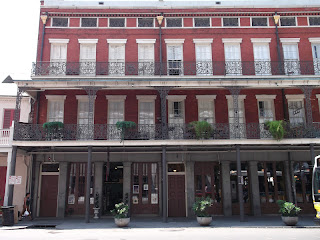 |
| Beignets served at Cafe du Monde 24/7 |
 |
| Cafe du Monde at Jackson Square |
"Only two spots left!" the horse carriage driver bellowed. At Jackson Square, several of these vehicles depart at a time.  They wind around the streets, the nimble horses hooves rhythmically clicking against the pavement like long fingernails tapping on keyboards. On the opposite side of the street, one of the main landmarks in the city-Cafe du Monde- is open day and night. Inside, flocks of waiters and waitresses flutter around tables, as tourists sit down to vaccuum in the snow-covered, irregular-shaped donuts, excited to be in a restaurant that never closes.
They wind around the streets, the nimble horses hooves rhythmically clicking against the pavement like long fingernails tapping on keyboards. On the opposite side of the street, one of the main landmarks in the city-Cafe du Monde- is open day and night. Inside, flocks of waiters and waitresses flutter around tables, as tourists sit down to vaccuum in the snow-covered, irregular-shaped donuts, excited to be in a restaurant that never closes.
 They wind around the streets, the nimble horses hooves rhythmically clicking against the pavement like long fingernails tapping on keyboards. On the opposite side of the street, one of the main landmarks in the city-Cafe du Monde- is open day and night. Inside, flocks of waiters and waitresses flutter around tables, as tourists sit down to vaccuum in the snow-covered, irregular-shaped donuts, excited to be in a restaurant that never closes.
They wind around the streets, the nimble horses hooves rhythmically clicking against the pavement like long fingernails tapping on keyboards. On the opposite side of the street, one of the main landmarks in the city-Cafe du Monde- is open day and night. Inside, flocks of waiters and waitresses flutter around tables, as tourists sit down to vaccuum in the snow-covered, irregular-shaped donuts, excited to be in a restaurant that never closes.
On the opposite side of the square, St. Louis' Cathedral regally reaches to the night sky, as statues cast giant shadows that enthrall photo-takers.
 |
| St. Louis Cathedral interior, at Jackson Square |
The second Cafe du Monde location is in another section of town, near the view of the bustling Mississippi River. A small cafe du monde is surrounded by the competing stands doing their best to sell the hottest hot sauce on earth, while long barges float, seeming clumsy, much like a Hummer or limousine trying to find a parking space in a crowded parking lot. It is closer to the port where coffee entered the United States for the first time in the 1700's. so  people quickly grew fond of the unique taste in their cup, thus still adding it to Louisiana coffee to this day.
people quickly grew fond of the unique taste in their cup, thus still adding it to Louisiana coffee to this day.
 people quickly grew fond of the unique taste in their cup, thus still adding it to Louisiana coffee to this day.
people quickly grew fond of the unique taste in their cup, thus still adding it to Louisiana coffee to this day.
History
In the middle ages, the Spanish made bunuelos, fried flour-water balls. The French made a similar concoction called beignets (from the word beigne which means to raise), and took them to Louisiana, where it became a staple, and was declared the state donut in 1986. In New Orleans, Cafe du Monde began serving strong coffee and beignets since 1862, during the Civil War.
The New Orleans coffee served along with the beignets has chicory (endive root, related to lettuce) in it, because it was added to stretch coffee supplies during the French civil war, when it was scarce. It added body and flavor.
 |
| Pontalba Building, at Plaza de Armas (Jackson Square) |
1 tablespoon yeast
3/4 cup of warm water (110 to 115 degrees)
1/2 cup of evaporated milk
1/4 cup of granulated sugar
1/2 teaspoon salt
1 egg
2 tablespoons shortening
3 1/2 cups of flour
 |
| Homemade beignet dough |
 |
| Homemade beignet squares |
 |
| Roller for cutting beignet dough into squares (Cafe du Monde, Riverwalk) |
 |
| Homemade beignets fresh out of frying pot |
 |
| Beignet frier at Cafe du Monde, Riverwalk |




No comments:
Post a Comment